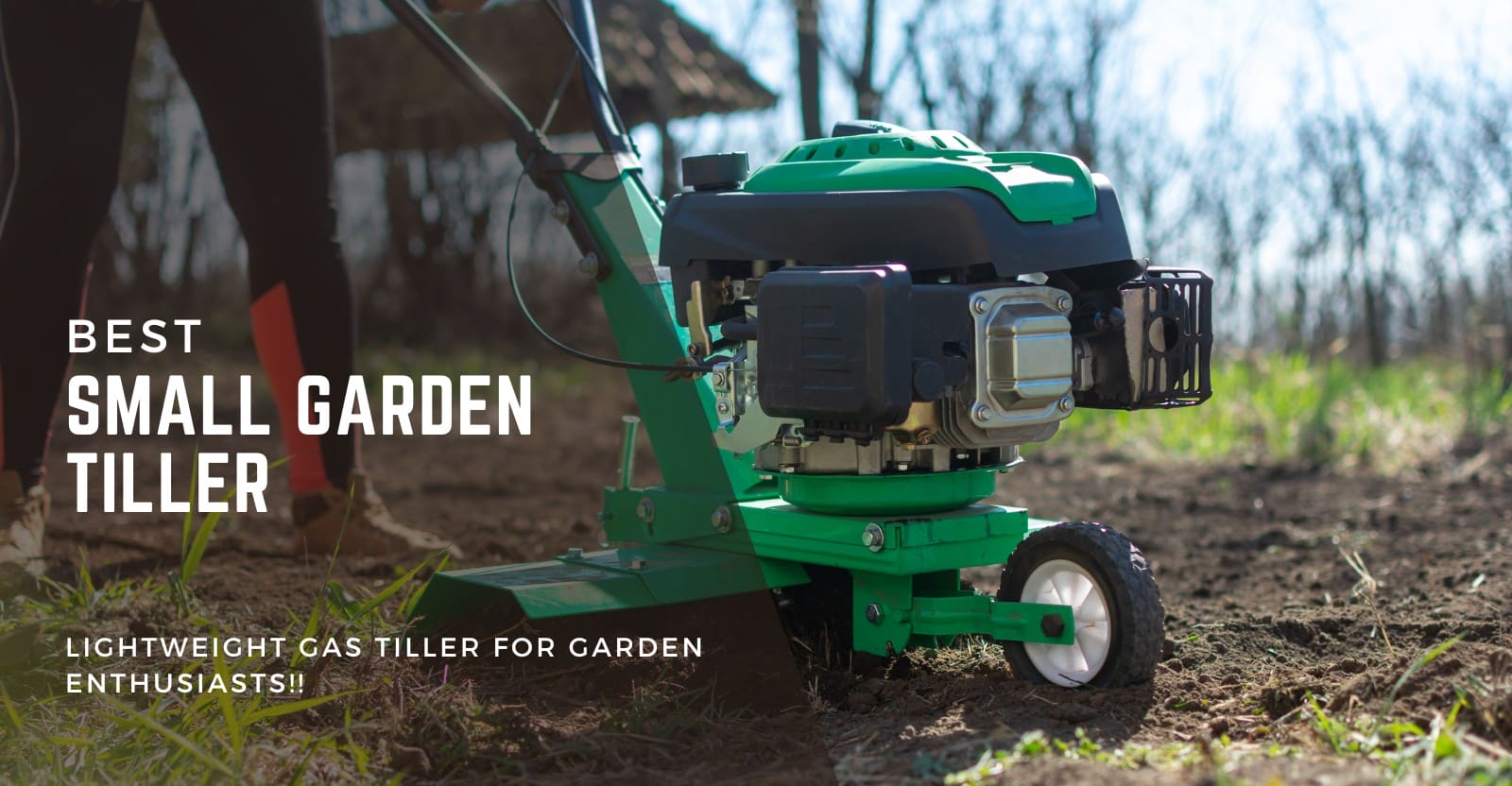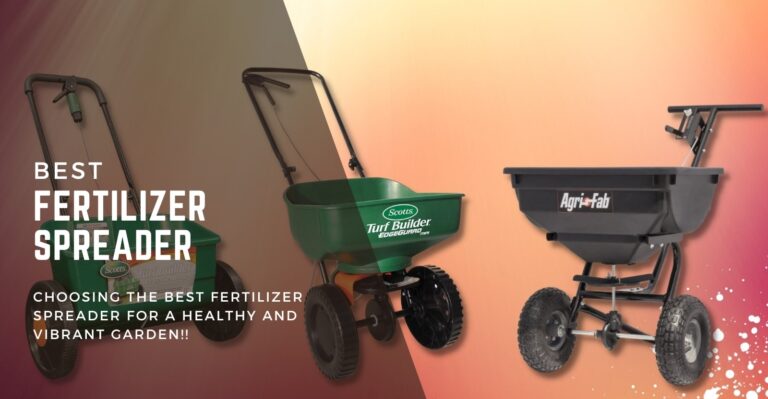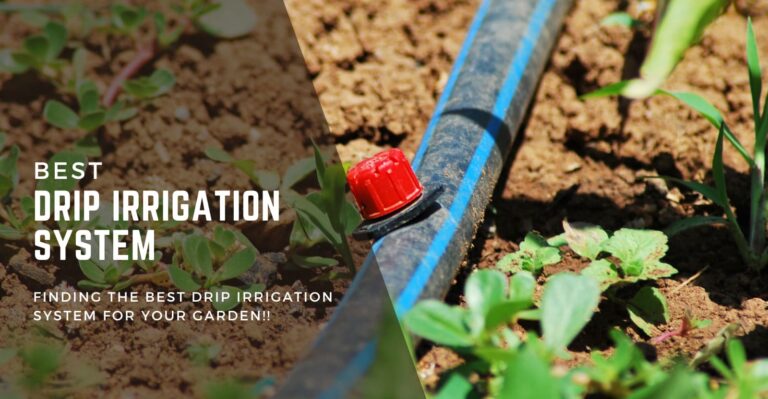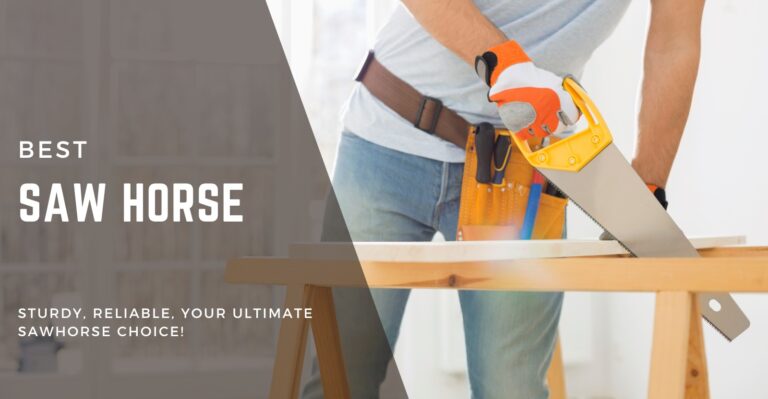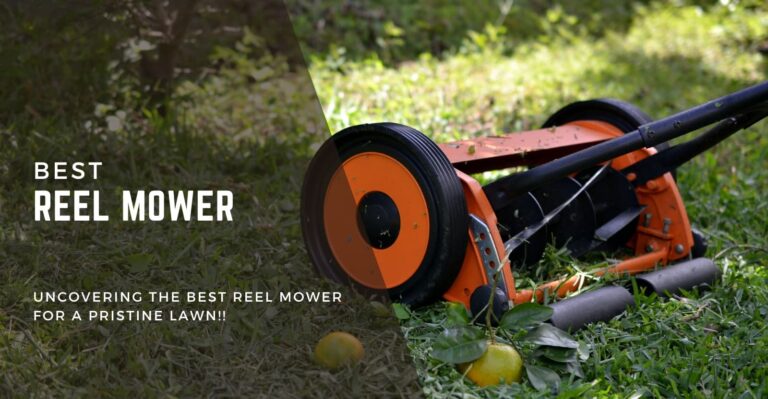Amazon has put together some great Home Gift Deals – save money and get your shopping done at the comfort of your home! Click here to see deals on Amazon
When you’re looking for a small garden tiller, you have to make sure you buy the best one. Spend some time to research available garden tillers in the market and have a clear understanding of your requirements.
Fortunately, there are several tillers and cultivators available to prepare your garden for planting. We’ll identify a few of the best small garden tiller on the market below and explain which ones will work best for different applications.
But first, let’s talk about why tillers are so helpful and explain some considerations you need to make when buying them for your garden. If you’re in a rush, you can also choose anyone from our quick picks.
Quick Picks
We may earn a small commission, at no cost to you, when you buy from our link to support us. More
Schiller Grounds Care Mantis Tiller Cultivator
It’s a lightweight gas-powered cultivator that comes with strong tines. You can fold handlebars for easy storage, and the unit has a 2-year limited warranty.
Earthquake Cultivator
It’s a great cultivator that can weed, mix in fertilizer, mulch, or aerate the soil with ease. The small size and lightweight cultivator have overhand control features. The 2-cycle viper engine is the best in its class.
Yard butler garden twist and tiller
Simple and easy-to-use manual tiller that comes with an extra-long handle to reduce the twisting effort. Cultivate around shrubs and bushes with ease. It comes with a lifetime warranty.
10 Best Small Garden Tillers To Buy
Product
Name
Detail
Price
- lightweight 21 lbs
- till 10 inches deep
- 240 RPM tine
- lightweight 20 lbs
- 2 cycle gas engine
- till 10 inches deep
- till width 8.25 to 10 inches
- foldable handle
- Lithium battery
- Cultivates up to 325 square feet per charge
- 33 cc gas engine
- height adjustable wheel
- 38 inch tall
- 12 inch T-handle
- Cushioned handle
- 3 position wheel adjustment
- 2 year warranty
- corded tiller
- 380 RPM
- reinforced tines
- List 12 Ah lithium battery
- 7.5 inch cutting width and 6 inches tilling depth
- 54 inch hardwood handle
- cushioned grip
- 4 curved steel tines
Our Top Pick
Our top pick for the best small garden tiller is the Earthquake cultivator.
It’s a sturdier tiller/cultivator that can handle all types of pre-tilled ground surfaces. Its small size and very lightweight making it easy to transport and highly maneuverable around delicate plants.
Should you buy a small garden tiller?
If you have a small garden or narrow space where you want to till your soil, a short-yard tiller is suitable. The size of the rototiller you may need depends on the garden space and the soil’s condition.
For a large area, you may want to consider a longer and heavy-duty walk behind tiller that allows you maximum tilling depth and width. But for most people who have a small residential plot, the small garden tiller works best.
It gives you enough power to get the job done without taking up much storage space. This works best for regularly maintained soil where the soil has been already dug in the past.
You can use these tillers to break down large clumps of the earth so that you can grow your plants.
What to consider when buying a small garden tiller
Engine
You have the option to choose a gas-powered or electric-powered engine. For small yards, it’s better to choose an electric-powered engine, for everything else, choose a gas-powered one.
Blade
A sturdier constructed blade and its length determine how deeper you can till in the ground. Choose a blade depending on the soil type in your yard.
Ergonomic Handle
An ergonomic handle gives you a much smoother operation without getting tired. You can choose a moveable handle for the ability to have a single-hand operation.
Have a question about buying a small garden tiller? Contact us
Small Garden Tiller Reviews
1. Mantis 3-Speed Electric Cultivator
Mini Garden Tiller
When you’re looking for powerful mini tillers for small yards, Mantis electric tiller/cultivator is the right choice.
It’s a lightweight and powerful electric rototiller that is suitable for any residential garden. It only weighs 21 pounds, which makes it easy to carry and maneuver.
The compact design and balanced motor at the top of the tiller allow you to get in tight spaces. You don’t have to worry about damaging small spaced ornamental plants while tilling.
The reversible tines are sharp and sturdy that you can use to till down 10 inches deep or shallowly cultivate the tops 2 to 3 inches of soil. The folding handle makes it easy to store without taking much space.
You can choose three-speed settings that allow the serpentine tines to spin up to 240 RPM. It can break through hard and tough soils.
This is an electric corded tiller, which means you have to keep it plugged into the power source to keep it operational.
You have to buy an extension cord, depending on the size of your yard. But you don’t have to worry about filling up a gas or dealing with harmful exhausts.
See More Information about: Mantis 3-Speed Electric Cultivator
Pros
Cons
2. Schiller Grounds Care Mantis Tiller
Soil Tiller For Any Garden
The Schiller grounds care tiller is a lightweight, high-performance 2-cycle gasoline-powered cultivator. The engine is placed directly over the tines for maximum rototilling and digging power.
The compact size of the cultivator allows you to work in practically any size space. You can conveniently use it to till and weed close to flowerbeds, walls, and fences.
The ergonomically designed handle is comfortable to use. The soft, flared grip on the handle makes it easy to control without getting tired. You may need to do some assembling before you start using this machine. But it comes with detailed instruction that is easy to follow.
The engine is located above the tiller that keeps it stable. The engine kill switch is near the grip that making it quick to stop in case of emergency. The tiller has a 10-inch tine depth.
The cultivator has enough power that you can use for most types of soil. You can use it to prepare a new flower bed and get started with planting.
It has a 2-cycle engine, which means you have to mix oil and gas to keep it running. But you can always buy the premixed fuel to save yourself the hassle.
See More Information about: Schiller Grounds Care Mantis Tiller
Pros
Cons
3. Greenworks 10-Inch 8 Amp Corded Tiller
Best Electric Rototiller
The Greenworks 8-amp corded tiller is an excellent choice for gardeners. Its powerful and robust build motor provides excellent results.
The reliable, easy electric starts configuration means you don’t have to worry about mixing fuel and oil or deal with emissions that happen when using gas-powered tillers.
The sturdier tills work significantly in rocky, clay, or stony soils. The built-in safety mechanism will stop overburdening the engine when it hits something that it can’t handle.
The adjustable wheels allow you to set the depth up to 5 inches. Four 8-inch forward rotating tines give high performance in digging any soil type.
You can also adjust the tilling width from 8.25 inches to 10 inches. It’s straightforward to use and very lightweight. You can quickly put flower beds or remove grass and weeds from the yard in less time.
It’s rated for 120 V A/C input that is commonly available for North American markets. The safety start button allows you to safely operate the machine without worrying about accidental starts by children.
Overall, it’s a great tiller for any light to medium type of soil moving job. It works optimally when the soil is neither too wet nor dry.
It’s a corded tiller, so make sure you get an extension cord depending on your garden’s size.
See More Information about: Greenworks 10-Inch 8 Amp Corded Tiller
Pros
Cons
4. BLACK+DECKER 20V MAX Tiller
Top Performing Tiller
If you’re looking for a highly portable tiller, consider a Black + Decker 20V Cordless tiller. It’s an excellent tool for smaller gardens and lighter jobs.
You can use it to prep beds for planting flowers or vegetables and prepare the ground for seeding. You can use lithium-ion batteries to cultivate up to 325 sq. feet of planted beds after fully charged.
It’s also a handy tool for quick weeding and doing aeration to your plants. The handle of the tiller is adjustable and has a supporting handle.
You don’t have to bend while using the tiller, as the telescopic handle allows you to adjust at your desired length. You can dig up to 4 inches deep in the ground without getting tired.
The counter-oscillating tines stop weeds from tangling. The soft-grip handle gives you added comfort while operating the machine.
The cultivator has a battery and charger included, and the total weighs approximately 8 lbs.
See More Information about: BLACK+DECKER 20V MAX Tiller
Pros
Cons
5. Earthquake Mini Tiller Cultivator
Best Tiller for Small Garden
The Earthquake mini tillers cultivator is perfect for gardeners who have medium to large sizes of garden. It’s a powerful mini cultivator with 33 cc, 2 cycle viper engines.
You can use it to weed, mulch, mix fertilizers, or aerate the soil with ease. The small and compact size design allows you to use it in narrow spaces and maneuver around delicate plants.
The sturdier tines do a great job breaking up the ground in a forward or reverse direction. The removable tines offer a larger 10-inch width for tilling and smaller 6-inch width for cultivating.
The adjustable digging pattern means you can maintain short digging spacing. Controls are located near your hand for better stability and operation. Overhand control reduces the bouncing and jumping on the unit to easily remove weeds.
The handle isn’t adjustable, but overhand grip and throttle arrangements allow both forward and backward operation easy. You can easily maneuver around delicate flower beds and plants.
Height adjustable wheels allow you greater depth control. For smoother transportation, you can remove tines and quickly assemble them again.
See More Information about: Earthquake Mini Tiller Cultivator
Pros
Cons
6. Yard Butler Manual Garden Weeder Cultivator
Budget Manual Cultivator
If you’re looking for a manual weeder cultivator for a small-sized garden, then Yard Butler is a great choice. Since it’s a manual tiller, you don’t have to worry about filling gas or hunting for an electrical socket. You can use it wherever you need it.
It’s great for use on raised garden beds and flower boxes. As it’s a manual tiller, you may not want to use it for never tilled soil. It may take more power and effort to get the job done.
You can use it to complement the mini-powered tiller with this hand unit to cultivate any leftover spots. The handle is long enough to make a comfortable grip and twist it around for breaking the soil or weeds.
You can use it to prepare the ground for flower beds and planting. The cultivator works great around shrubs, bushes, and other hard-to-reach surfaces. It comes with a lifetime warranty.
See More Information about: Yard Butler Manual Garden Weeder Cultivator
Pros
Cons
7. Sun Joe 12-Amp Electric Tiller and Cultivator
Electric Tiller For Small Yard
The Sun Joe electric tiller and cultivator is a compact design with features of several higher-end models. It has a powerful 12-amp motor that cultivates up to 16 inches wide and 8 inches deep.
There are 6 durable steel angled tines for maximum durability and performance. The 3-position wheel adjustment gives you added flexibility to adjust the height.
The handles are foldable to make it easy and convenient to store or transport. It’s an electric tiller with an instant start feature. You can use it to ground up your soil, even on a small amount of rocky or hard surfaces.
This cultivator is great for the garden and small yards. You can use it for medium size yards, but a shorter blade means it takes longer to get the job done. The handle isn’t adjustable, but it should work fine for a medium-height person.
See More Information about: Sun Joe 12-Amp Electric Tiller and Cultivator
Pros
Cons
8. WEN 14.2-Inch Electric Tiller and Cultivator
Electric Tiller For Compressed Soil
Wen 14.2 inches electric tiller delivers the power to get a tough job done. It has a 7-amp motor that moves tines at 380 RPM. There are four reinforced steel tines to use for easy cultivation.
The non-slip airless wheels are sturdy and keep the machine adequately balanced on an uneven surface. You can also remove these wheels for easy transportation and storage.
The overload protection mechanism automatically stops the motor when it hits any hard rock, concrete, or other immovable surfaces.
Overall, it’s a great electric cultivator suitable for small-sized gardens that you can use to till soil up to 14.2 inches wide and 8.7 inches deep. It comes with a two-year warranty.
See More Information about: WEN 14.2-Inch Electric Tiller and Cultivator
Pros
Cons
9. Earthwise 7.5-Inch Cordless Electric Tiller Cultivator
Best Lightweight Cordless Tiller
If you want a small cordless electric cultivator, Earthwise electric tiller delivers on the expectation. The unit is powered by a 20 V, 2 Ah lithium-ion battery for long-lasting performance, run time, and durability.
It’s a great mini tiller suitable for moving soil in a small garden and flower beds. You can use it to clear the area from weeds as well. It has 4 durable steel tines that can cultivate up to 7.5 inches wide and 6 inches deep.
The lightweight design makes it easy to operate and store. The supporting handlebar is wide enough to maintain a comfortable grip on a large handle. The soft ergonomic grip handle makes it easy to control and keep it balanced.
It’s a great eco-friendly alternative to gas-powered lawn and garden tools. The unit comes with a 12-amp battery and a fast charger.
See More Information about: Earthwise 7.5-Inch Cordless Electric Tiller Cultivator
Pros
Cons
10. True Temper Forged Cultivator
Heavy Duty Manual Cultivator
True Temper forged cultivator is a manual tiller that you can use anywhere in your garden. It’s lightweight and has small tines that allow you to pull out grass or mix the soil.
There are 4 small curved, forged steel tines. The cushioned end grip makes it easy to handle without getting tired.
54-inch hardwood handle makes it easy to reach tough spots at flower beds or raised garden beds. It’s a great handy tool for tilling and aeration in hard rocky soil.
See More Information about: True Temper Forged Cultivator
Pros
Cons
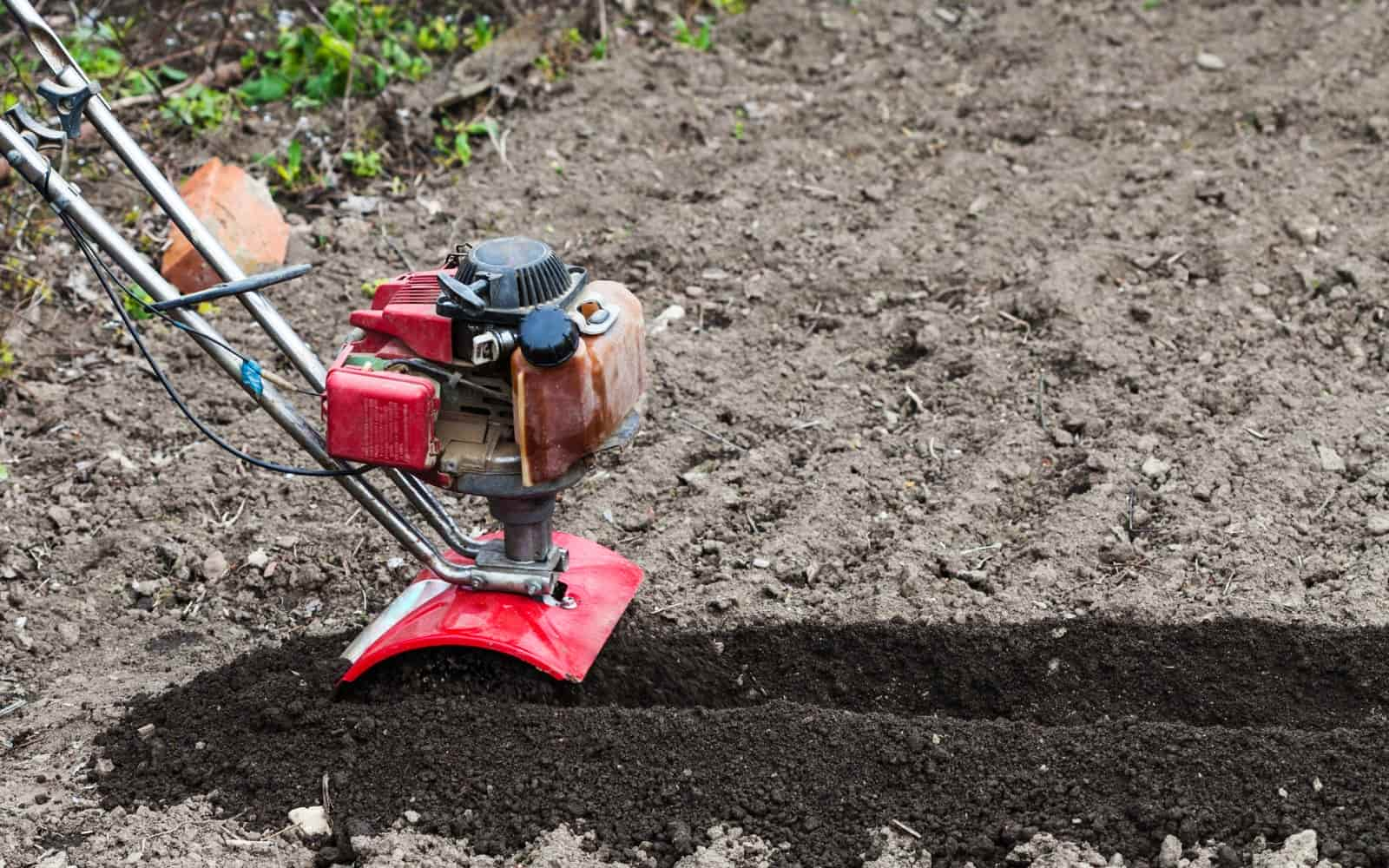
What’s the difference between a tiller and cultivator?
Tiller and cultivators are practically the same things. They both accomplish the same task, which is breaking the ground. However, the difference arises depending on the machine’s size and the soil hardness it can handle.
Cultivators are a small size than tillers, and they’re suitable for maintaining small garden beds. Tillers are usually bigger and are ideal for breaking the hard ground surface.
Cultivators work best on the already dug-up ground as it helps mix loose soil. Tiller works great when it comes to breaking up the hard and challenging soil surface. It’s great when you’re building up new garden beds.
Here is the summary of the tiller vs. cultivator
| Tiller | Cultivator |
|---|---|
| Used for breaking up the soil surface | Used for mixing loose soil |
| Great for working on a new garden | Need to have already developed soil surface |
| Can work on hard rocky ground | Can remove small weeds and grasses or blend compost |
| Suitable for medium to large size yards | Smaller and more manageable to maneuver |
When choosing between cultivator and tiller, you should consider the area and the soil surface to pick the right tool. Here is a summary when deciding which tiller to buy depending on square feet area:
- Cultivator: When you’re dealing with loose, pre-tilled soil and area under 1,000 sq. ft
- Front tine tiller: For moderately compacted soil and area up to 5,000 sq. ft
- Rear tine tiller: For highly compacted or rocky soil, ideal tiller for an area over 5,000 sq. ft
What are the different types of tillers?
Small garden tillers are also known as cultivators or mini-tillers. These use metal blades that dig in the ground and move to break up the soil. There are three types of tillers that you can buy.
Front Tine tiller: Front tine tiller has blades at the front of the unit and directly under the engine. These are high-performance rototillers suitable for land areas less than 1,000 sq. feet. These are simple to operate and cost-effective.
The tiller’s simple design means you have to push ahead while maintaining the direction you want to mow along. It’s suitable for garden beds with a small to medium level of soil compaction.
Mid-tine tiller: It has tines located in the middle of the machine, making it easy to control and maneuver. The engine, usually a gas engine, is placed directly above the tine to provide you with better weight distribution.
It’s not as robust as rear tine but suitable for any light to the medium job of creating new seedbeds.
Rear tine tiller: It has a tiller located at the backside of the engine. This design allows you to get more power and can dig deeper into the soil. You should choose this if you’re breaking new ground or have a rocky or heavier soil surface.
These produce less vibration even on stony ground, which means you won’t get fatigued quickly. For better soil traction, it has large wheels with sturdy treads and adjustable regulators.
You can move soils at different depths. Some rear rototillers come with counter-rotating features that provide you with more control when handling tough dirt.
Are electric garden tillers any good?
When it comes to powering the tiller, you have an option to choose either an electric or gas-powered tiller. Now, there are some apparent benefits of the electric tiller.
These are simple to start, won’t generate any emissions, and are convenient to use. While on the other hand, you can use more powerful gas tillers to use anywhere without worrying about an electric power supply or running around with an extension cord.
The performance of an electric tiller depends on Amp motor inside the unit and the blade design. For most residential purposes, you should choose an engine above a 12-amp motor.
Electric tillers are suitable for any small to medium size yard and have a moderate level of soil compaction. These are sturdy, lightweight, and cheaper to operate. Electric tillers are great for most residential or urban gardening jobs.
What should you look for in a mini tiller?
When choosing a mini-tiller, consider the following factors to ensure you’re not buying a machine that is either under power or overpowers.
Soil type
You should choose a small yard tiller based on the soil you will be moving in your garden. You should consider getting a rear tine tiller for any rocky, compact, clay, or unbroken soil. It gives you sufficient power to plow through the tough ground.
But if you’re dealing with softer, finer soil and need some digging to plant seeds, then choose a smaller and lightweight electric tiller.
Engine
The tiller engine can be gasoline-powered or electric-powered. The mini gas-powered machine usually has a 1–2 HP engine.
The electric engine can be either corded or cordless types. These are lightweight and highly portable. The lightweight and easy operation make it user-friendly to both new and experienced gardened.
When choosing a mini-tiller, consider the required storage space as tilling isn’t something that frequently happens.
A small motor in the engine makes it lightweight, but you have to check if it can handle your garden’s soil type.
Blades
Tiller blades with sturdier construction and length determine how deep you can go in the ground. There are three types of edges in the tiller.
- Bolo tiller blades: These can dig deeper into the soil and break it apart.
- Slasher tiller blades: This works best in the soft ground that has roots or plants on it. These are great when removing weeds or clearing the older plants and vegetation.
- Pick and chisel tiller blades: These are very sturdy and work significantly on the hard, rocky soil surface. These are high-intensity impact blades that are sharp and durable to break down the toughest soil into fine smaller particles.
Weight
A lightweight tiller is suitable for a small garden. There is no reason to use a more powerful but heavier tiller when your needs are to remove some weeds and get soil prepped for planting.
Small and lightweight also allows people with limited mobility or strength to do the tilling. You can handle different gardening tasks such as cultivating and aeration without getting tired.
Also, you don’t have to worry about a counterweight to keep the tiller balanced and steady.
Ergonomic Handle
The ergonomic handle can be either fixed or adjustable. We recommend that when it’s possible, look for an adjustable handle.
This gives you a much smoother operation when tilling and reduces the chance of accidentally ruining the flower bed.
The moveable handle also allows you to have a single-hand operation. You can move out of the way while tilling, so you’re not walking on freshly tilled soil.
Also, check if the handle length is long enough to operate the machine without putting a strain on your hand and wrist.
Warranty and Service
Most tillers come with a limited 2-year warranty. Some may have different conditions of what they cover under the warranty and the service you can expect.
Choosing a tiller with an extended warranty on quality means you will have added peace of mind that you will be covered if something goes wrong.
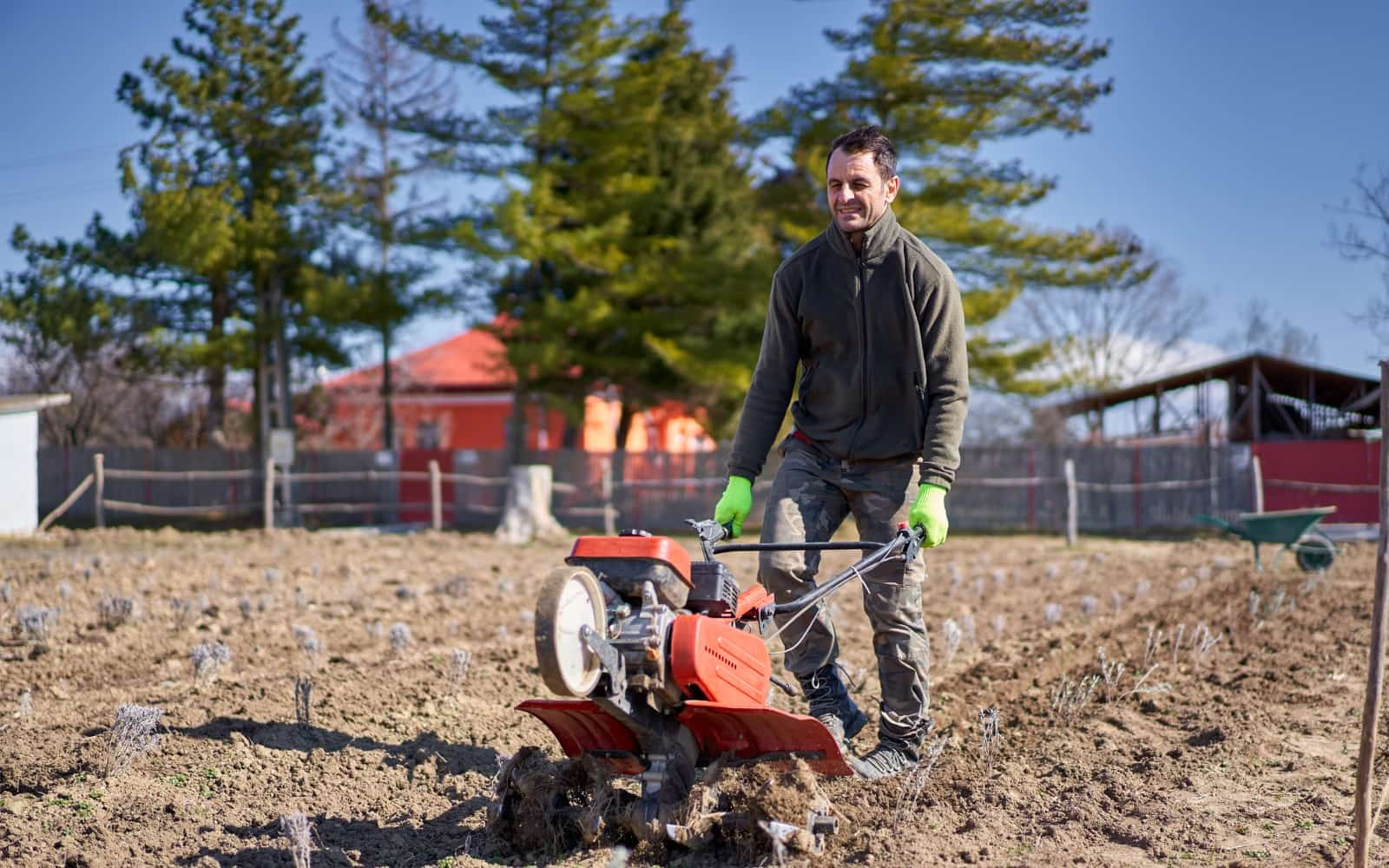
When should you start tilling your garden?
People have different opinions when it comes to tilling an entire lawn or garden. Some believe that tilling at least once or twice a year is sufficient, while others think tilling isn’t needed at all.
When it comes to time to start tilling your garden, it’s right at the start of spring (March-April) when the ground has thawed after the winter, and you get ready to plant seeds.
Before you start tilling, check the ground to make sure it’s dry and not frozen. You should also dig a few inches deep into the ground to check if the soil is warm enough.
You can put your finger in the soil or use a soil thermometer to test the ground that it’s not stiff or frozen. For successful seeding and tilling, you want the land to be over 60 F.
You can start tilling before and after planting season. This means the best time to begin cultivating is in fall and spring.
It gives fertilizers and nutrients enough time to get in the soil and break down, so the ground becomes ready for spring planting. If you choose to grow fall plants, you can till when the harvest is over but before the winter.
Tilling at the start of winter makes weed seeds exposed to the soil surface. It kills the weed seeds’ germination ability before they can start growing in spring.
Can you plant immediately after tilling?
The primary purpose of tilling is to move the ground to mix the ground nutrients, remove weeds, and help with aeration.
Generally, you can plant immediately after tilling, but for the best result, you should wait at least 2–3 weeks before you start growing.
You should check your soil before tilling and don’t till on wet ground as it compacts the earth, leading to low root growth in the growing season.
Waiting sometime after tilling allows the soil to retain its balance again that helps with the plant growth. When you cultivate, it disturbs the beneficial micronutrients in the ground. Waiting for a few weeks allows them to settle in and replenish the soil nutrients.
If you’re tilling in spring, waiting a few weeks before planting allows you to remove any weed germination before planting seeds.
How to prepare a garden without a tiller?
When it comes to preparing a garden, you should know how to make the best use by nurturing and improving the soil. It will work wonders on your plot, even with challenging soils like heavy clay or chalk.
Having a tiller helps make the job more comfortable as you can quickly break and mix soil and nutrients. You can still prepare your garden without a tiller, though.
You can use a shovel to dig and mix soil manually. Follow these steps to prepare your garden for planting:
Step 1: Remove any weeds or old plants from the garden bed. You can either rake the area or use a garden spade to do the cleaning.
Step 2: Using a shovel, dig the top 2–4 inches’ layer to loosen the ground.
The purpose of digging is to reduce the soil compaction that hinders the air and rooting channel. Compacted soil also impairs drainage and reduces microorganism activities inside the ground.
Step 3: Dig a 15 to 20 inches wide hole where you want to plant. Use tine to loosen the soil around the hole without collapsing the hole.
A loose soil inside the hole allows the plant root to spread quickly.
Step 4: Add organic fertilizer such as compost, plant clippings, or manure inside the hole to provide nutrients to the plant.
Step 5: Carefully plant inside the hole and cover the area with loose soil. Pay attention to details ensuring that there is sufficient water drainage across the soil surface.
Step 6: Repeat the step until you get your garden ready and plant the flowers or vegetables you want to grow.

Where can you take the broken garden tiller for disposal?
Most municipalities won’t allow you to dump broken outdoor power equipment into a garbage bin. If you’re using a gasoline-powered tiller, there is a fire risk due to fuel and lubricant left in the machine.
Depending on the place you live, you should check with the local administration’s recycling programs. You will get instructions on where to dispose of broken tools.
You should view the accepted items and how to prepare it for disposal safely. Another option is to check with scrap metal sites or private recycling companies that may take it either free or for a small fee.
For any leftover gasoline in the tiller, empty it into ULC approved container such as a jerrycan.
We hope this guide has been helpful. Please comment with any of your experiences, recommendations, or information regarding mini cultivators.
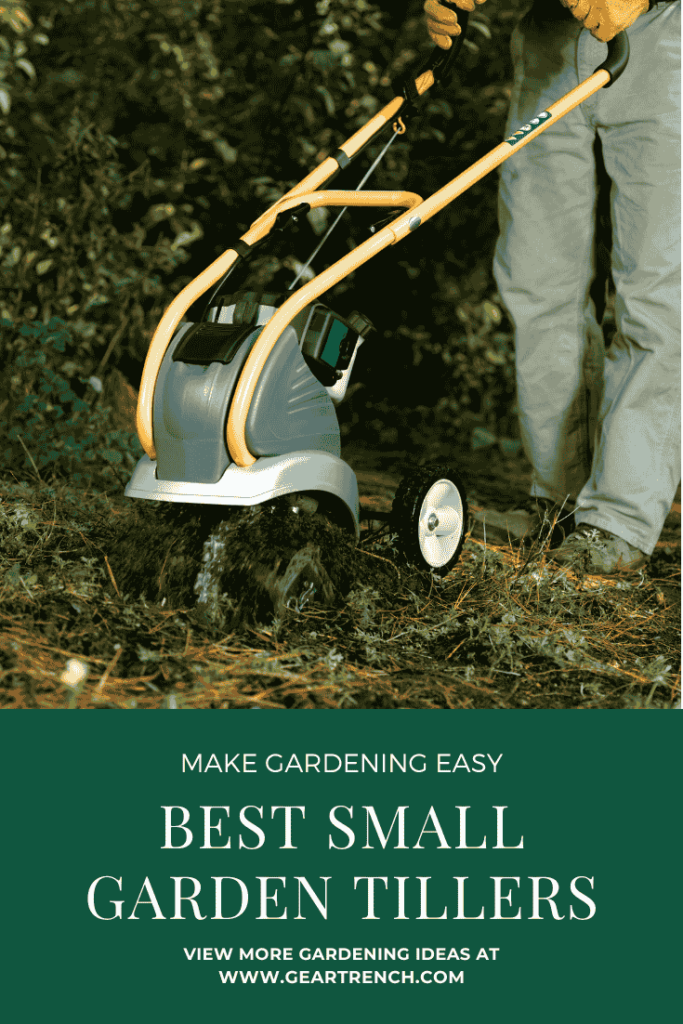
Don’t forget to share this post

